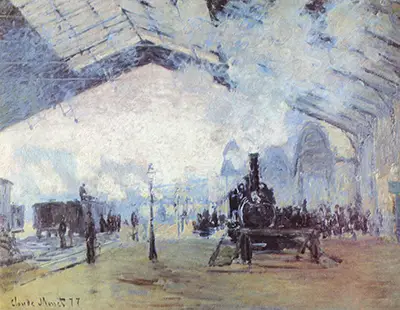The series consisted of 11 pieces. This series is part of Monet's most famous artworks. He had spent years painting in the country-side and had decided to shift his focus to urban landscape painting.
At this time, he was drawing inspiration from painters regarded as modern painters such as Manet, Degas, and Caillebotte. As part of his endeavors to be considered a painter of modern life, he made a request to work on the Gare Saint Lazare station that had its boundary marked on one side.
The train station is Paris's largest and busiest. This was a perfect setting for Monet whose emphasis fell strongly on sunshine reflections and effects of light on a painting.
The Gare Saint-Lazare II painting was overwhelming to the viewer, not through its modest scale but through the massive steam of smoke that engulfed the whole canvas. The Gare-Saint Lazare is a view of one of the passenger sections of the train station.
The theme of the painting involves rays of light filtering through the thick smoke. The locomotives in the station seem to dominate the site. Light was given priority as a formal element in this painting as was the norm with most of Monet's impressionist artwork. Monet depicted a bright and strived to bring out the effects of pure sunlight.
The Gare-Saint Lazare has been regarded to as the most impressive artwork in impressionism. Claude Monet had developed an extreme disregard for all academic art painting guidelines at the time. This had resulted in the rejection of his works in an exhibition called The Salon.
His technique involved heavy brushstrokes and the Gare Saint Lazare was no exception. Monet applied an impasto technique on this painting, which involved a thick application of paint that left the surface of the canvas rough.
As a result of his disregard of academic art guidelines at the time, Monet's artwork lacked favor among judges of various exhibitions at the time. He, therefore, partnered with other like-minded artist and they went on to work and do exhibitions together.
He worked with artists such as Pierre-Auguste Renoir, Camille Pissarro, and Alfred Sisley to form an independent exhibition for impressionists. At the time of painting the Gare Saint-Lazare, Monet was drawing inspiration from artists who were seen as painters of modern life. He, therefore, borrowed a leaf from the works of Manet, Degas, and Caillebotte.
Women in the Garden - Monet did this painting in the year 1866 at the young age of 16. He used the painting to participate in the salon exhibition of 1867. It was however rejected as a result of Monet's use of heavy brushstrokes.
The setting of the painting was a garden of a property Monet had rented from his cousin Paul Eugene Lecadre. His cousin's wife posed for the figures of the women in the garden. This painting is very popular among Monet's Works in impressionism.
Camille or The Woman in the Green Dress - This painting was done by Monet in the year 1866. It is the painting that shed some light on Monet as an artist. It fetched Monet a whopping 800 francs. This was quite a handsome sum for a struggling young painter at the time.
The painting featured his first wife Camille Doncieux, clad in a green dress. This painting featured the conventional painting guidelines at the time as opposed to impressionism techniques that he would adopt later.


